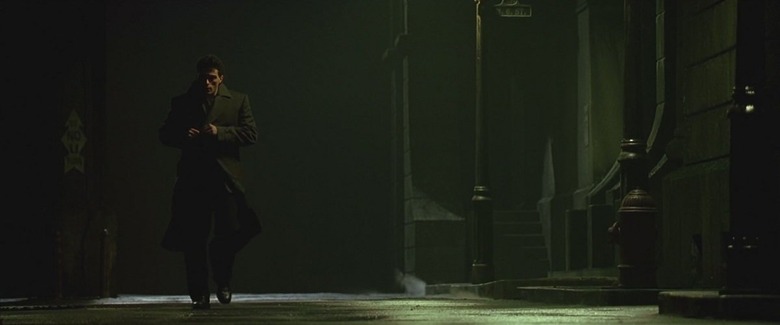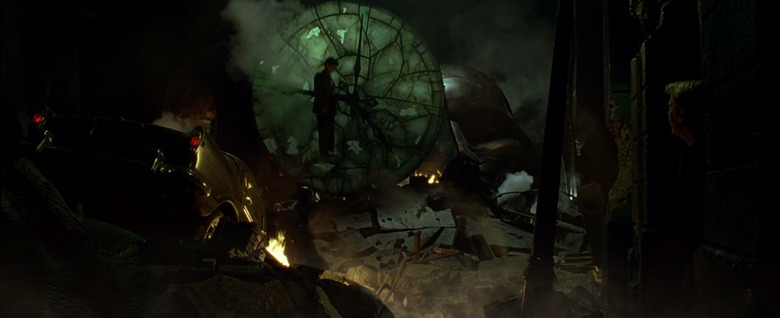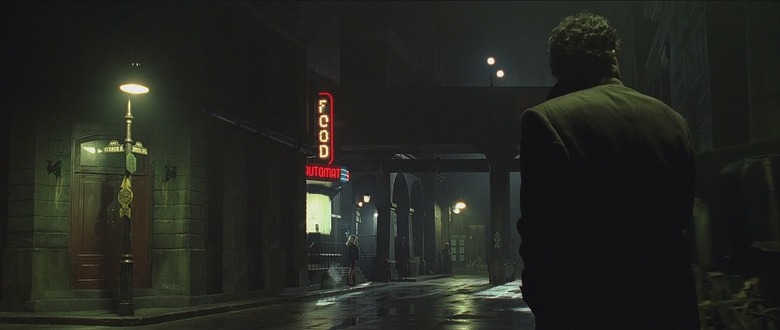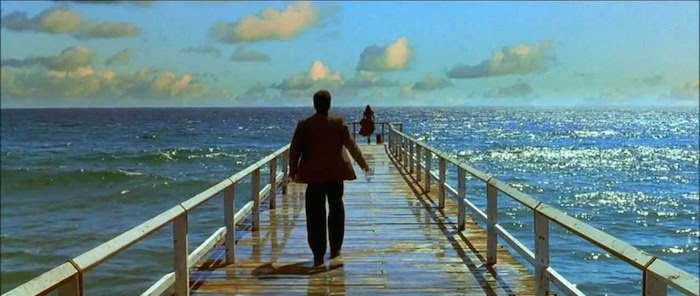20 Years Later, 'Dark City' Remains One Of The Smartest Sci-Fi Films Ever Made
Alex Proyas' Dark City turns 20 today, a science fiction masterpiece that is at once undeniably influential in its field yet still overlooked by many fans of the genre. That commercial neglect may be due in part to the theatrical version, which opened with a studio-mandated voice-over narration that compromised Proyas' vision – as well as that of his co-writers, Lem Dobbs and David S. Goyer – and spoiled the film's compelling mystery before it even began.
In the theatrical version, as we sink through the cosmos into a city street bathed in night, Kiefer Sutherland's Dr. Schreber gives us answers to questions we haven't even thought to ask yet: "First, there was darkness. Then came The Strangers." We learn that The Strangers are an ancient race whose inhabitants have mastered the "ultimate technology: the ability to alter physical reality by will alone." We learn that they're dying, that their civilization is in decline, and so they've abandoned their home and searched for a cure across the stars, before finding themselves on a "small blue world, in the farthest corner of the galaxy. Our world." Although there's still much to be learned in Dark City, the solution to its biggest riddle is handed to us in the first fifty seconds of the film.
Whereas Proyas' superior Director's Cut has the audience awaking into the middle of a mystery much as John Murdoch (Rufus Sewell) awakes – suddenly, perplexingly, with only our wits to give us context for what we see onscreen. Murdoch is naked, without his memories, lying in a tub in a bleak hotel bathroom. Behind the hotel bed is the butchered body of a woman, her flesh carved with concentric spirals. In this version of the film, it doesn't yet occur to viewers that another mystery might need solving beyond the simplest, most immediate questions: who is John Murdoch? Is he responsible for the serial murders we learn are taking place across this nameless, timeless, lightless city? We have plenty of screentime to go before the epiphany that the murders are nothing more than a false flag in the midst of The Strangers' nightly experiments on the human condition – and this knowledge is more gratifying thanks to the work we've done to get there.
While the ambiguity of the Director's Cut makes for a more successful narrative approach, the theatrical version cannot hide and no voice-over can spoil the plain truth about Dark City: that this is a film of ideas, strange and fascinating and beautifully illustrated by some of the most astonishing visual effects of its time, or of the two decades that have followed. Those ideas, though original in their expression, are steeped in philosophical and psychological theories going back decades, even centuries. Dark City is a movie, in other words, that rewards you for doing your homework. Of course you can enjoy the film on its surface as an entertaining sci-fi noir, but there's a complex nervous system running beneath this metropolis of perpetual night, a network of ideas and conceits that all aim to answer one question: what makes us human? What makes us us?
Memoirs of My Nervous Illness
Kiefer Sutherland's character – the doctor who has reluctantly assisted The Strangers in their experiments and works to help Murdoch free humanity from their control – is named Daniel P. Schreber, after a German judge who suffered from paranoid schizophrenia and wrote about his experience in an asylum. Daniel Paul Schreber's Memoirs of My Nervous Illness is a revelatory psychological text because Schreber wrote it both during and after bouts of madness, with insight into his own affliction that no external party could ever offer. Freud and Jung were both fascinated by the book and its author, with Freud suggesting, "The wonderful Schreber...ought to have been made a professor of psychiatry and director of a mental hospital" (from the book's intro, written by Rosemary Dinnage).
Much has been made of Schreber's description of "fleetingly-improvised men" as an influence on Dark City – transient human shapes that occasionally resemble dead people and whose existence is fleeting and immaterial. It's a pretty good description of The Strangers, but the connection between Memoirs of My Nervous Illness and Dark City goes beyond their shared villains into the very substance (or lack of substance) of their worlds. As Dinnage says, "The Memoirs are an account of what it is to be forsaken by everything familiar and real, and of the delusionary world that gets invented in its place." Every night at midnight in the Dark City, a delusionary world is invented, keeping its inhabitants from the comfort of familiarity or reality.
Meanwhile, Schreber writes of God's egoism – "particularly in the form of the instinct of self-preservation, which at times demands the sacrifice of other beings for one's own existence." The Strangers are the gods of Dark City's universe, and they sacrifice human memory and personality in the search for their own preserved existence. They even use our dead as their vessels, quite literally sacrificing other beings for their own self-preservation.
Memoirs of My Nervous Illness has a LOT to it – it's one of the most fascinating books on psychology ever written, and reading it reveals dozens of slighter influences on Dark City. Schreber is not only represented in the film by Sutherland's character, through his name and his quest for answers, but also by Murdoch, who has lost his identity and, in searching for it, becomes capable of great feats of supernatural power, as Schreber in his delusion believed of himself. And he's represented by the mad, retired Detective Eddie Walenski (Colin Friels), in his desperate certainty that the world around him is wrong, even if no one else can see it. Daniel Paul Schreber is in every word and idea behind Dark City, a film that is as much about the search for self as it is about bald aliens and murdered prostitutes.
Last Thursdayism
The circular newness of Dark City's nights also nods to Last Thursdayism, a theory that the universe might have been created very recently (last Thursday, for instance), but with the appearance of being much older. It works both as a somewhat flippant description of a Young Earth creationist explanation (first suggested by naturalist Philip Henry Gosse as the Omphalos hypothesis) for, you know, fossils and stuff, which aren't accounted for by a literal interpretation of Genesis. But it's also a thought experiment: if you remember events from before last Thursday, does that mean it's impossible that the earth was only created last Thursday? Or is it possible that the god that created a planet last week and made it appear billions of years old also implanted memories of a life before last Thursday into your mind?
Obviously the concept of implanted memories is extremely germane to Dark City's whole deal, but there's also the idea that a world can be old and new at once. The city in Dark City is one out of time, with cars and automats and fashions and architecture that reflect dozens of different points in our cultural history. Even before we, the viewers, understand that this world is a fairly recent construct, we can't place where or when it's meant to exist. And just because John Murdoch has flashes of memory – a happy childhood vacation to Shell Beach, for instance – doesn't mean he's ever been to Shell Beach, or that Shell Beach was ever really a place, or that John Murdoch was ever really a child. All of this could have been created – both in his mind and externally – last Thursday.
Allegory of the Cave
Perhaps the best-known philosophical concept that helped shape Dark City's narrative is Plato's Allegory of the Cave. In the early 16th century, Plato wrote in his Republic an imagined conversation between classical Greek philosopher Socrates and Plato's brother Glaucon, in which Plato's Socrates conceives of a group of people who have lived their entire lives chained to a wall in a "cave-like dwelling." They see life only reflected as shadows on the cave's wall, and believe that is their entire reality. Plato says the purpose of the philosopher is to be the prisoner freed from the cave, who sees life as it truly is and (eventually, after much pain, rage and blindness from the sudden light) understands that the shadows are just that: shadows of existence, not existence itself. After this revelation, the freed prisoner may return to the cave with the hope of sharing what he's learned with his fellow prisoners, but they could not understand, and his sudden blindness as his eyes readjust to the dark would be interpreted as a consequence of his journey.
And the final outcome: SOCRATES: And if they can get hold of this person who takes it in hand to free them from their chains and to lead them up, and if they could kill him, will they not actually kill him? GLAUCON: They certainly will.
See also: Tennyson's "The Lady of Shalott." Also The Truman Show. And The Matrix. And many, many other works in the couple thousand or so years since Plato first imagined that cave.
Of course here Murdoch is the freed prisoner, who – after much pain, rage and blindness – learns that his dark city is one of shadows rather than substance, and who would free his fellow prisoners even as they chase him down and accuse him of murder. But he frees them anyway. Because – like Truman, and Neo, and, well, not so much The Lady of Shalott – it is his destiny to do so.
Images That Matter
Science fiction works best when it's based on more than advanced technology and inventive world building. Dark City offers stunning visual effects, described by Roger Ebert in his legendary commentary for the film as "new things," the entirely rare opportunity to show something new in a world saturated with images. But it's the history and ideology behind those new images that make them stick, that make them matter.
And even still, Proyas, Goyer and company never rely solely on intellectualism to sell Dark City's story. With all of the heady concepts and thoughtful philosophy behind the film, what many viewers remember best (and the scene most frequently homaged in other cinema) is that of Jennifer Connelly standing on a bright pier, overlooking the ocean. After all, Dark City proposes, what makes us human isn't our thoughts, our neural pathways, even our memories. As John Murdoch tells The Strangers before shaping his world into one of sunlight rather than shadows, "You were looking in the wrong place."




